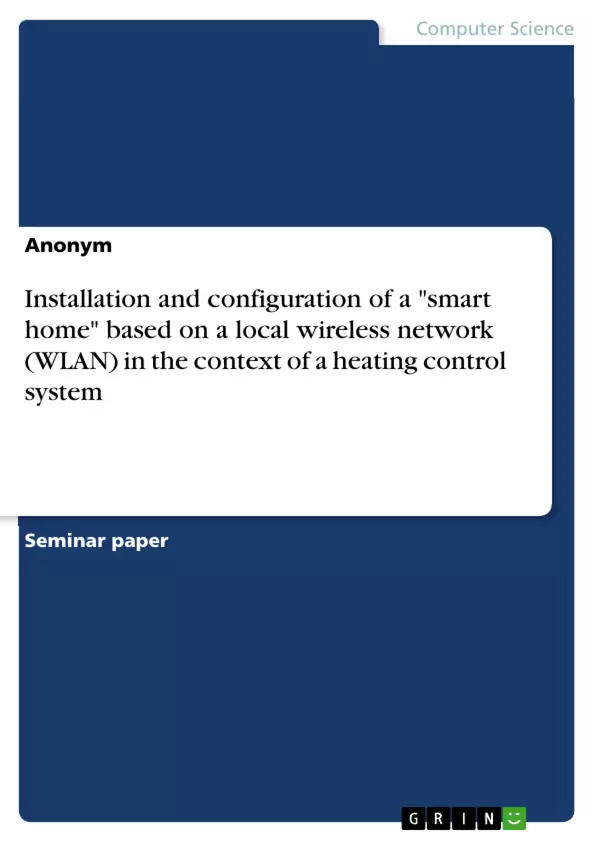This thesis deals with the installation and configuration of a "smart home" based on a local wireless network (WLAN) in the context of a heating control system.
In today's world, the comfort of the home takes centre stage. It's not just about having a nice home, but being able to use it effectively (saving energy) and, above all, as comfortably as possible. In this homework, one aspect of the "smart home", heating control, is addressed. This aspect will be used to illustrate an example and show what is possible in a "smart home". Even if the focus is on comfort, the costs saved by a smart home should not go unmentioned.
It is obvious that a heating control system that is constantly monitored and adapted to the ambient temperature causes less variable costs than a heating control system that permanently heats at a set, specific level. The following scenario is assumed for an illustrative example: A small family, father, mother and teenage son, have been living in a condominium for some time. The tech-savvy father decides to gradually convert the large flat into an intelligent home. He starts converting the heating systems in the autumn in order to save on heating costs over the winter.
Inhaltsverzeichnis (Table of Contents)
- 1 Introduction
- 2 Terminology
- 3 Required peripherals (hardware)
- 3.1 Switching centre (system component)
- 3.2 Heating thermostat (sensor and actuator)
- 3.3 Window and door contact (sensor)
- 3.4 Room thermostat (sensor)
- 3.5 Smartphone (actuator)
- 3.6 Voice control (actuator)
- 4 Technical realisation
- 4.1 Overloading the 2.4 GHz network
- 4.2 Commissioning
- 4.2.1 Installing and configuring the control centre
- 4.2.2 Installing and configuring the actuators and sensors
- 4.3 Realisation costs
- 4.4 Savings
- 5 Safety
- 6 Summary & recommendations for action
Zielsetzung und Themenschwerpunkte (Objectives and Key Themes)
This paper explores the installation and configuration of a "smart home" heating control system based on a local wireless network (WLAN). The paper aims to illustrate the benefits of smart home technology, particularly in the context of energy savings and comfort. It focuses on a specific scenario of a family converting their condominium into a smart home.
- Benefits of smart home technology
- Energy savings through heating control
- Implementation of a smart home heating system using WLAN
- Technical aspects of installation and configuration
- Cost-benefit analysis of smart home heating
Zusammenfassung der Kapitel (Chapter Summaries)
- Chapter 1: Introduction This chapter introduces the concept of smart homes and highlights the focus on energy savings and comfort. It presents a scenario of a family converting their condominium into a smart home by starting with the heating system.
- Chapter 2: Terminology This chapter defines key terms relevant to smart home technology, such as WLAN, sensors, and actuators. It provides a foundation for understanding the technical aspects of the system.
- Chapter 3: Required peripherals (hardware) This chapter outlines the hardware components necessary for implementing the smart home heating system. It describes the switching centre, heating thermostat, window and door contacts, room thermostat, smartphone, and voice control.
- Chapter 4: Technical realisation This chapter delves into the technical aspects of implementing the smart home heating system. It covers topics like network overloading, commissioning, installation and configuration of the control centre and sensors, realization costs, and potential savings.
- Chapter 5: Safety This chapter addresses safety considerations related to the smart home heating system.
Schlüsselwörter (Keywords)
This paper focuses on the key concepts of smart homes, heating control, WLAN, sensors, actuators, energy savings, comfort, and technical implementation. It explores the use of smart home technology for practical application in a residential context.
- Citation du texte
- Anonym (Auteur), 2017, Installation and configuration of a "smart home" based on a local wireless network (WLAN) in the context of a heating control system, Munich, GRIN Verlag, https://www.grin.com/document/1496795



